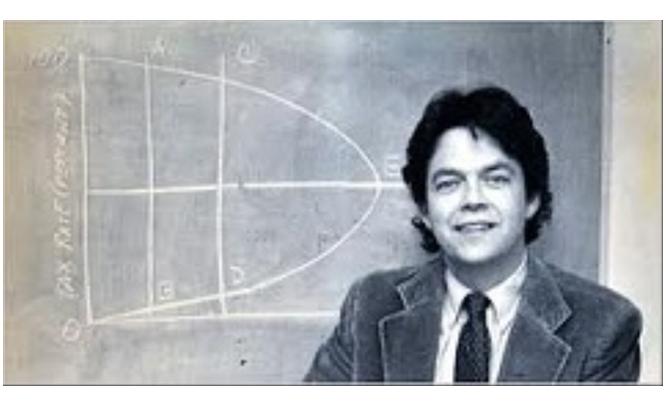The “Laffer Curve” is a theoretical curve showing the relationship between applied income tax rate and the resulting government revenue.
The term “ Laffer Curve” was coined by Jude Wanniski (former associate editor of the The Wall Street Journal) in 1978 when Wanniski penned an article named “Taxes, Revenues and the Laffer Curve”. In December 1974, Wanniski who was the associate editor of The Wall Street Journal along with Arthur Laffer, Professor at the Chicago University, Donald Rumsfeld ( Chief of Staff of to President Gerald Ford) and Dickey Cheney (Rumsfeld’s deputy) were discussing President Ford’s WIN (Whip Inflation Now) proposal for tax increases at a restaurant in Washington, Laffer grabbed a napkin and a pen and sketched a curve on the napkin illustrating the tradeoff between tax rates and tax revenues, Wanniski later named it as the “Laffer Curve”. A humble and honest academician who served Former U.S. President Ronald Reagan’s Economic Advisory Board, Arthur credited the theory to 14th century Muslim scholar Ibn Khaldun and eminent Economist John Maynard Keynes.
What does it actually mean ?
The “Laffer Curve” is a theoretical curve showing the relationship between applied income tax rate and the resulting government revenue. The theory propagates the following points:
- A tax rate of zero would result in zero government revenue
- A tax rate of 100% will also result in zero government revenue
- As the tax rate increases to above zero, there is an increase in the revenues of the government
- As the tax rate continues to increase, the resultant increase in government revenue begins to slow
- At a particular point the curve peaks and turns back towards the horizontal axis
Between these two extremes of (zero taxation and 100 percent tax rate) there are two tax rates that will collect the same amount of revenue: a high tax rate on a small tax base and a low tax rate on a large tax base. The arithmetic effect is static, which means when the taxes are lowered, the tax revenues per dollar of tax base will be lowered by the amount in the decrease in the rate and vice versa. The economic effect recognizes the positive impact that lower taxes have on work, industrial activities which in turn increases these activities. The curve also demonstrates what happens when arithmetic and economic forces collide, explain why a tax increase may reduce taxed activity and raise less revenue than predicted, just as a tax cut would increase revenues to the government.
Assumptions and Criticisms
There is no single “Laffer Curve” or a set-in-stone point at which increased tax rates cease to generate government returns. There have been occasions where increased tax rates clearly resulted in increased government revenue and also a decreased tax rate resulting in increase government revenues. The curve is different for different types of taxation and not the same for each income bracket, for example: the curve would be different for personal income tax, corporate income tax and capital gains tax. The curves for these different taxes and tax rates will begin and end at the same place, but the area between slope and point of diminishing return is certainly not the same. The economic climate prevalent in the countries would also introduce lot of variables such as the general economic growth rate, interest rates, consumer confidence, inflation and many others; all of these variables contribute to the shape of the curve.



